Intel Meteor Lake — all the big Intel Core Ultra news and new AI laptops announced
Meet the new AI superchip for laptops

The end of the year is nearly here, and Intel did its best to close 2023 with a banger by formally unveiling its new AI-focused chips during a press event today (Dec 14).
This was the big showcase for the company's new Intel Meteor Lake chips, the first Intel laptop chips fabricated using the sort of "chiplet" design already in use by competitors like AMD. This method allows Intel to basically "stack" different chiplets together to make a chip, and that in turn should make them more power-efficient by giving Intel more options to shunt work to lower-power portions of the chip or shut down whole sections entirely when they're not in use.
Speaking of sections, these new Meteor Lake chips have four distinct parts: CPU, GPU, I/O (input/output) and an SoC (System on Chip) area where the new AI tech lives. That's where you'll find the new NPU (Neural Processing Unit) with its AI inference engines and an island of low-power cores optimized for "AI" workloads like image processing, generating text from LLMs and more.
This is where Intel is clearly hoping to generate some excitement, which is why it's using phrases like "the age of the AI PC is here" — these new chips are optimized for tasks that your PC's CPU and GPU currently aren't, and Intel is hoping people will be excited enough about the possibilities of doing "AI" stuff locally (like using AI to enerate your own GTA VI trailer in 30 minutes on your laptop, instead of having to go online) to go out and buy new laptops and desktops in 2024.
However, the company didn't say anything about Meteor Lake coming to desktops during today's event. While we expect that will come at some point, so far Meteor Lake chips are mobile-only. Intel and its partners have already started loading up laptops with these new chips here at the end of 2023, and we expect many more to debut next year at CES 2024 and beyond.
But you don't have to wait to find out what it's like to use one of these new "AI laptops" because we've had the chance to go hands-on with three already, and you can read our impressions in the articles linked below.
Beneath that you'll find the record of our liveblog from Intel's "AI Everywhere" event, where you'll find blow-by-blow accounts of the presentation and photos captured live from the event by our own Tony Polanco.
Intel Meteor Lake Launch: Latest News
- Intel Meteor Lake ‘AI laptops’ have landed — here’s 5 you can buy right now
- Acer Swift Go 14 Meteor Lake hands-on: The AI laptop has arrived
- MSI Prestige 16 AI EVO hands-on: This AI laptop could be a game-changer
- Using an Intel Core Ultra laptop for anything other than AI is a bit meh — my time with the new Asus Zenbook 14 OLED
Good morning! We’re warming up the liveblog as we get ready to hear about what Intel’s got in store for 2024, and the phrase on everyone’s lips is Meteor Lake.
That’s the name Intel has chosen for its latest round of laptop chips, which we expect to debut today at 10AM ET (3PM for folks reading this in the U.K.). These Meteor Lake CPUs are a big deal for a lot of reasons, not least of which that they sport a new “chiplet” design and a new naming scheme. That’s right, from here on out no more talking about 13th Gen Intel Core i5-13600KFs or anything like that–with Meteor Lake the chip names are being simplified to “Intel Core Ultra #”, with the # at the end signifying how powerful it is. So an Intel Core Ultra 7 CPU should be more powerful than an Intel Core Ultra 5, for example, though we’ll see how widely this new branding scheme is used.
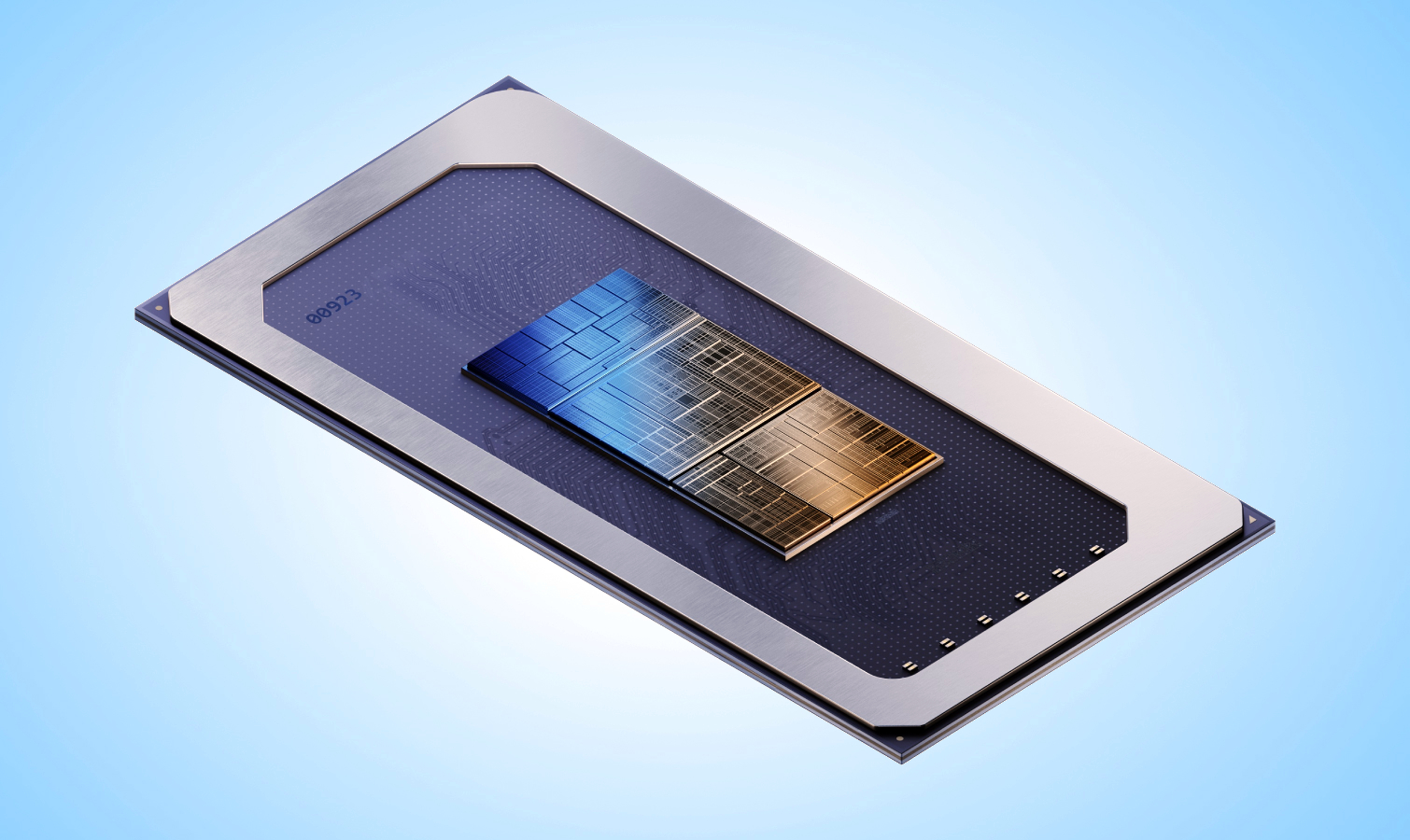
In addition to a branding change, Intel’s upcoming Meteor Lake chips are also the company’s first laptop chips to be fabricated using a “chiplet” design which stacks four different “tiles” together into one chip using Intel’s Foveros technology.
On a Meteor Lake chip the CPU tile holds the chip CPU, the GPU tile holds the integrated GPU, the I/O (input/output) tile handles connections like Bluetooth and Wi-Fi and the SoC (System on Chip) tile holds the NPU (neural processing unit), which is designed to excel at “AI” workloads like blurring the background of your webcam in real-time.
These new NPUs are what we expect Intel to spend a lot of time talking up today, and they incorporate a pile of low-power efficiency cores optimized for “AI” tasks. Think of them like the low-power efficiency cores in a current Intel laptop CPU, but even lower-powered – Intel has used the phrase “Low Power Island” to talk about this part of Meteor Lake, and it may help improve laptop battery life in the future by shutting off the main CPU tile and saving power when whatever you’re doing doesn’t require the full muscle of Meteor Lake.

While we wait for Intel’s Meteor Lake showcase to kick off, let’s quickly go over some of the improvements the company has proposed while talking up its latest laptop chips. When the company introduced us to Meteor Lake back in September, it walked us through 3 ways Meteor Lake chips will shake things up: better video calls, better graphics and better battery life for laptops. And we'll break down the first couple for you now.
These chips promise better video call quality by integrating an NPU with low-power cores optimized for doing “AI” tasks, like filtering background noise and blurring your background without tasking your CPU during video calls.
Better graphics will hopefully come from the higher-end Meteor Lake laptop chips, which will have integrated GPUs bearing the Intel Arc graphics card branding and supporting modern graphics tricks like ray tracing, supersampling and more. They still won’t compete with a discrete Nvidia GeForce RTX 4090, but they should be better than what your laptop can do right now.

Better battery life is also one of the main selling points Meteor Lake chips have stuffed up their sleeve. Hopefully this will show up in power savings from having tasks shunted to the low-power NPU. But also, the new Foveros packaging technology Intel is using to stack these Meteor Lake chiplets together allows individual tiles to be powered on or off at will, without affecting the rest of the chip, so we may see laptops lasting longer because they’re smart enough to switch off most of the power-hungry components when you’re just moving files around in Windows 11 or watching YouTube.

“But wait,” I can hear you screaming at your display. “Intel isn’t the only chipmaker on the block! Why all this hubbub about some new silicon from them?”
To that I say, friend, you are correct. There are many chipmakers circling the block in 2024, and they’ve all been steadily eroding Intel’s perceived dominance in the chip business. AMD just launched its own Ryen 8040 “Hawk Point” laptop chips due to show up in laptops starting next month, and Qualcomm has its new Snapdragon X Elite chips due to surface in laptops by mid-2024. And of course, Apple launched its own new Apple M3 chip just last month, and both AMD and Apple have been using chiplet designs and NPUs in their chipsets long before Intel got around to it.

Why is Intel is making such a big deal about unveiling Meteor Lake today? It’s partly because the company is playing catch-up and it knows it. When you hear big marketing messages about the age of the AI PC and how the AI laptop is about to revolutionize your world, remember: Intel is late to the party, and basically everything Meteor Lake can do is already being done on phones, tablets and laptops by chips from other companies.
The question we’ll start to answer today is: How good is Intel’s party entrance going to be? Is this really the inflection point where we’ll start to see and appreciate why we want on-device AI to be a major feature of our laptops, or are we going to walk away feeling like this is all a gimmick to jumpstart a PC industry desperate to sell more computers post-COVID?

AI is also going to play a major factor with Meteor Lake going forward. Over the next year we're going to see artificial intelligence move away from the big large language model tools like ChatGPT, requiring the latest GPUs and massive data centers to run.
The next year will see the dawn of what Microsoft calls the small language model. This is an AI tool that can run locally, and while they can run on a CPU the rise of the NPUs (Neural Processing Units), including those in Intel's new Meteor Lake Chips or Apple's silicon allow for much more efficient operation.

Cutting edge graphical technology obviously isn't something you'd normally associate with Intel. While AMD has cuddled up to the console space providing APUs for both PS5 and Xbox Series X, gaming has historically never been its major CPU rival's main priority. Although that said, the firm consistently delivers excellent desktop gaming processors, like the Intel Core i9 13900K.
While the upcoming Meteor Lake range isn't going to challenge Nvidia's finest GPUs anytime soon, Intel is at least making some enhancements that should interest PC gamers. The company is ditching Iris Xe GPUs in favor of new Arc integrated graphics chipsets.
Does that mean we'll see Meteor Lake laptops popping up in 2024 that can run Cyberpunk 2077 at 60 fps with full path tracing enabled? Probably not. Still, the addition of Arc chiplets should see support for gaming-focused features like supersampling, DX12 Ultimate and ray tracing.

Let's quickly circle back to the importance that AI is going to play when it comes to Meteor Lake's potential success. The prescence of Neural Processing Units (NPUs) really is a big deal.
They're developed with a data-driven parallel computing architecture which can handle vast amounts of information across different modalities such as video, image and audio very quickly.
This parallel computing is particularly important for large data tasks such as machine learning and artificial intelligence. What this means is that in the future we could see Microsoft's own Copilot AI running on-device and offline, with no sensitive data going out to the cloud, or image generation in the Photos app happening on your laptop.
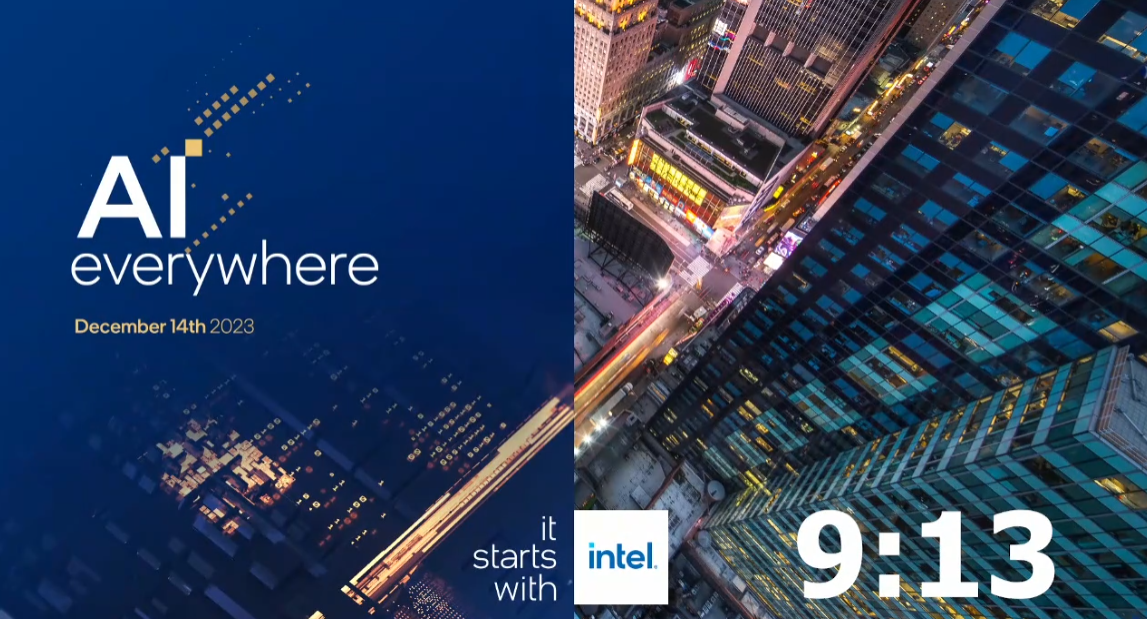
Good morning! Quick time check: It's less than 10 minutes to 7 AM out here on the West Coast, and we are ready to meet Intel's vision of the future. You can stay tuned here for live updates from the event as they happen, and you can watch along with us remotely by pointing your browser of choice to Intel's AI Everywhere event page — right now you can expect to watch a timer count down as you hear someone in the auditorium ask everyone to find their seats, including our own Tony Polanco who's on-site at the Intel event to get a first look at their latest tech.
"Please take your seats and silence your devices, the keynote will begin in 2 minutes" is what we just heard on the livestream, so get to it!

Here's a sneak peek at what it's like in the room at Intel's "AI Everywhere" event, where our own Tony Polanco will be checking out the latest tech and demos as we prepare to enter Intel's vision of our AI laptop future.
And here we go! Intel's "AI Everywhere" event livestream is off to the races, and up first we expect to hear from Intel CEO Pat Gelsinger — after a fancy sizzle reel showcasing New York and Intel's own accomplishments, of course.
Oh okay, Pat went for a full-on live introduction from a balcony overlooking New York. If I was a true New Yorker I could probably tell you which balcony it is, but sadly the best New Yorker I know is Tony Polanco and he's inside the Intel building right now, waiting for Pat to finish up his opening speech so we can get to the hot news.
Ooh, Pat's doing a live walk and talk of his opening speech while walking through a small kitchenette and into the small press room where Tony himself is seated! I confess, I'm a little impressed.

Now Pat's talking through his opening remarks on the "Siliconomy" and how he thinks we're just at the start of something big.
"Augmented intelligence, how we integrate it into our human lives, integrate it with our human intelligence," is what Intel prizes about AI, says Gelsinger. "How humans and technology come together [is] going to be powerfully enabled by AI."
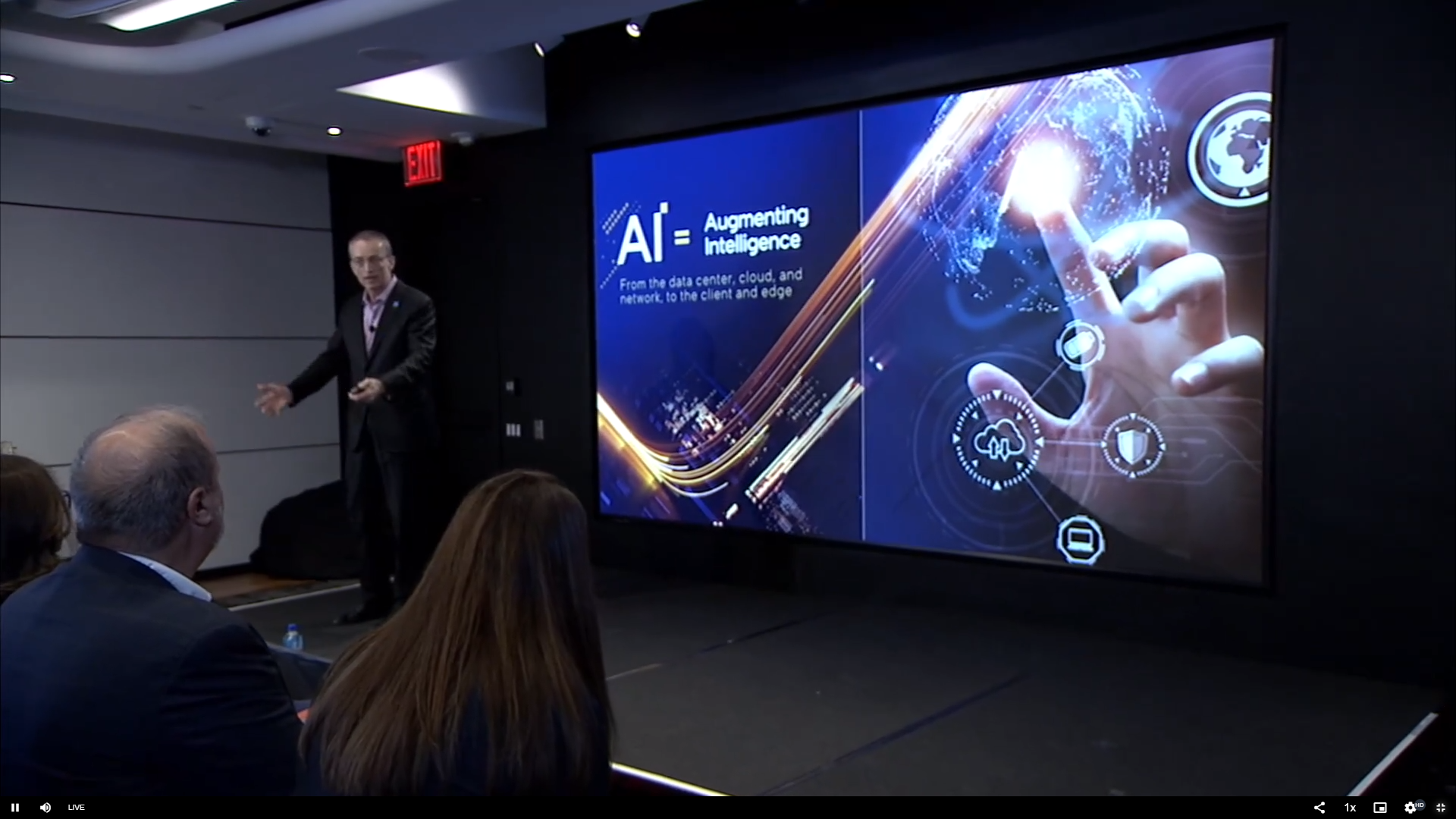
Now Gelsinger is talking up how Intel and other companies are eager to push AI into every corner of tech. Not just laptops or smartphones but servers, labs, data centers and more. He's also careful to slip in cautious statements about the dangers of AI, and how Intel is taking care in advancing it.

"We're uniquely positioned for this 'AI Everywhere' [because] we can put AI into everything we do," adds Gelsinger. "We're going to infuse [AI] into every data center."
Why all this talk about server farms and data centers? It's because Intel sells a lot of chips to companies running those big endeavors, and one of its big talking points during today's "AI Everywhere" event is Intel's new 5th Gen Intel Xeon processors, which are aimed squarely at data centers, cloud server farms and other big data centers.

"Intel is going through our transformation journey," says Gelsinger, as an image of the company's roadmap for chip development flashes up on displays behind him. He's now walking past display samples of Intel silicon as he talks up the company's plan to advance through five increasingly challenging stages of silicon design (Intel 7, 4, 3, 20A, and 18A) by 2025.
Intel's currently rolling a video roll of excited comments from partners, so let me take a second to tell you that we've already gone hands-on with several Meteor Lake laptops, and you can read about them now!

Okay, the sizzle reel is over and Intel exec Michelle Holthaus is taking the stage to introduce something new -- I'm betting Meteor Lake chips!

"Today I'm excited to announce the launch of the Intel Core Ultra," says Holthaus, holding a sample chip up to scattered applause.

"Imagine a laptop under 3 pounds that you can play games on, and it does double duty as its own AI processor," promises Holthaus. "And finally, it delivers its own neural processor."
She's talking of course about the NPU in these new Meteor Lake chips, which has dedicated AI engines and an island of low-power cores that are optimized for "AI" workloads like image processing, LLM generation and more.

Now Holthaus is walking through the chip specs, which you can also find in our Intel Meteor Lake breakdown. She's also explaining how Intel worked to make these chips deliver more power while sucking down less juice.

Now Holthaus has wrapped her initial remarks and invited Intel exec Jim Johnson on-stage to talk through performance demos of a game (in this case, the recently-released Ghostrunner 2) running better on these new Meteor Lake chips than it did on older Intel chips.
It's impressive, and I can tell you that I personally have played Ghostrunner 2 and other modern games on an Acer Swift Go 14 packing an Intel Core Ultra 7 chip and had a good time. So while these chips definitely aren't going to deliver top-tier gaming performance, they do seem to be better at handling demanding 3D games than older Intel CPUs with less advanced on-chip integrated GPUs.

Holthaus is back onstage now, and she says Intel is looking forward to Windows processes like Windows Copilot and Windows Studio Effects running on these new Intel Core Ultra chips.
Now I've already been using a laptop with Meteor Lake onboard so I've seen how it powers Windows Studio Effects, and it's basically just video call enhancements. What I haven't seen is Windows Copilot running locally on a laptop, rather than having to dial out to the Internet every time I ask it something. So that's one thing Intel's hyping I actually am excited to try out: Windows Copilot working on-device to help me with all aspects of my day-to-day computing, rather than just serving as a glorified Windows troubleshooter and Google Bard-alike.
And yes, Holthaus just confirmed that you can buy laptops packing these new Meteor Lake chips right now. We've already gone hands-on with a few, and we know that select partners (including Acer, HP, Lenovo and more) have hurried to get a few laptops updated with Meteor Lake and out to retailers in the U.S. and Canada.

Now Holthaus is handing a (gift-wrapped) Meteor Lake laptop to a musician who just talked up how these new AI chips help her generate music. "And the momentum doesn't stop here," adds Holthaus. "You're going to hear more in Q1", and I'm betting you're going to hear more as soon as the second week of January, when CES 2024 kicks off.

You'd think the event would end here, but nope Holthaus just invited Intel exec Sandra Rivera out on stage to talk up the company's 5th Gen Xeon processors and how they can supercharge data centers with AI.

"Today I'm pleased to launch our fifth-gen Xeon processors", says Rivera, holding up a chip. "This is the most power-efficient, performant" Xeon chip Intel has ever released, she says, and "we have built AI processors into every one of the processors's 64 cores."

These new Xeon chips will enable businesses to do things like deliver cloud-based language processing services up to 23% faster, claims Rivera.

Rivera is now welcoming Gallium Studios founder Lauren Elliott to talk up how the indie gaming company (co-founded by SimCity creator Will Wright) is using these new AI chips to fill the company's game Proxi with assets generated by LLMs (large language models) running on Intel's chips.
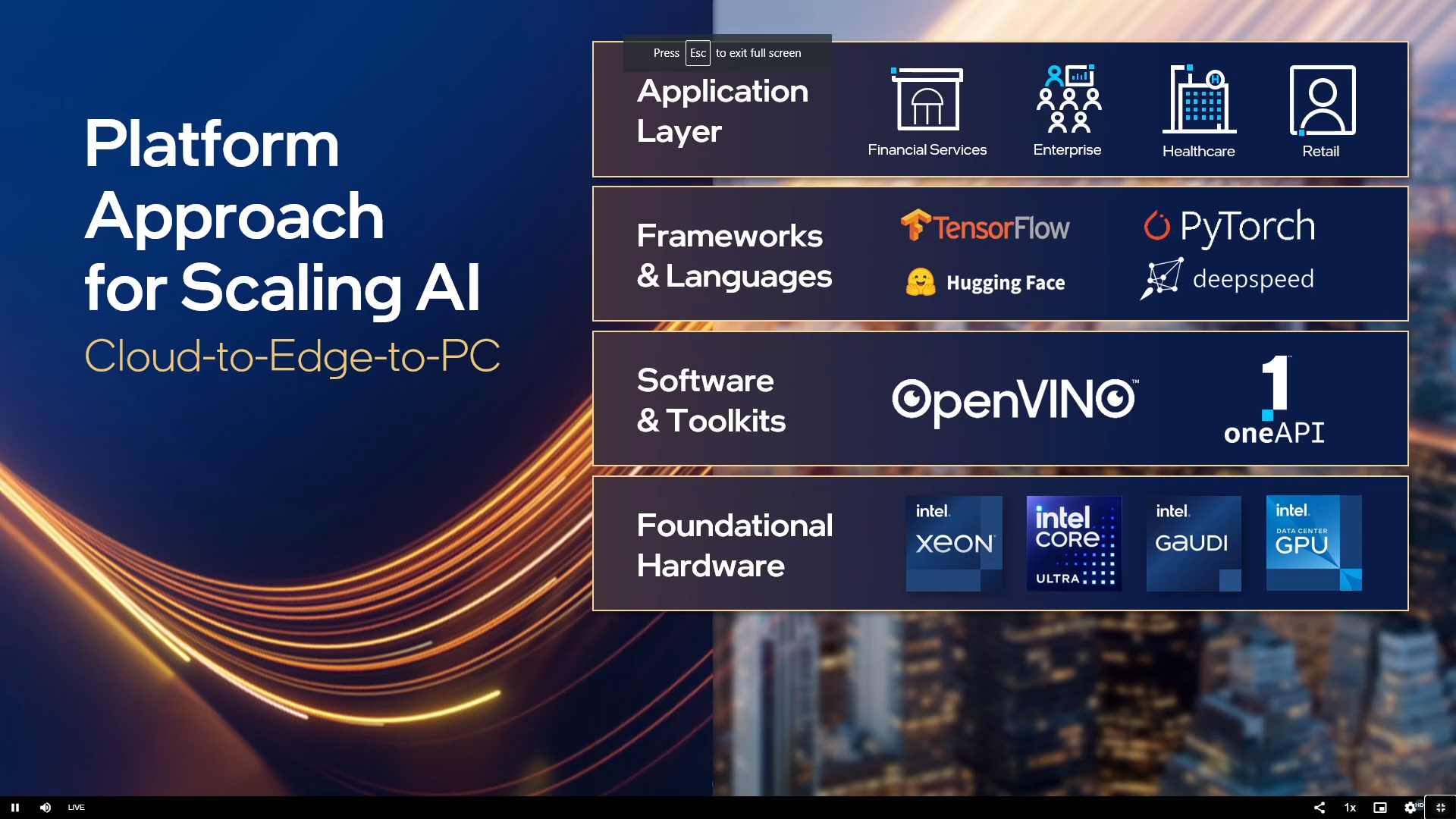
One key thing Elliott mentioned that I think we shouldn't gloss over: He talked up how these new chips were able to deliver better performance running large-scale generative AI models than GPUs.
Intel will ceaselessly talk up how these new Meteor Lake chips are capable of doing "AI" tasks that you've never seen before, ushering in an age of computing heretofore unknown to man. And that's all likely true, but what's key to remember is that these chips don't do totally new, never-before-done work: They're just optimized for "AI" tasks better than current CPUs or GPUs, which have until now been used to do things (like background blurring during video calls, or generating images from text) we're about to cede to "AI" chips.
So while Intel will likely continue treating the debut of Meteor Lake as a revolutionary event, it's key to remember that while this might be a revolution for Intel's tech and business, it's an evolution of where the PC industry has been heading for years now, led by companies like Apple and Nvidia.

Intel is now running a sizzle reel of partner representatives talking up how these new Intel chips enable/will enable them to do Great Things in business, like real-time translation, easy AI generation and more. So far the Hugging Face guy wins for having a neon sign of his company's logo hung up in the background.
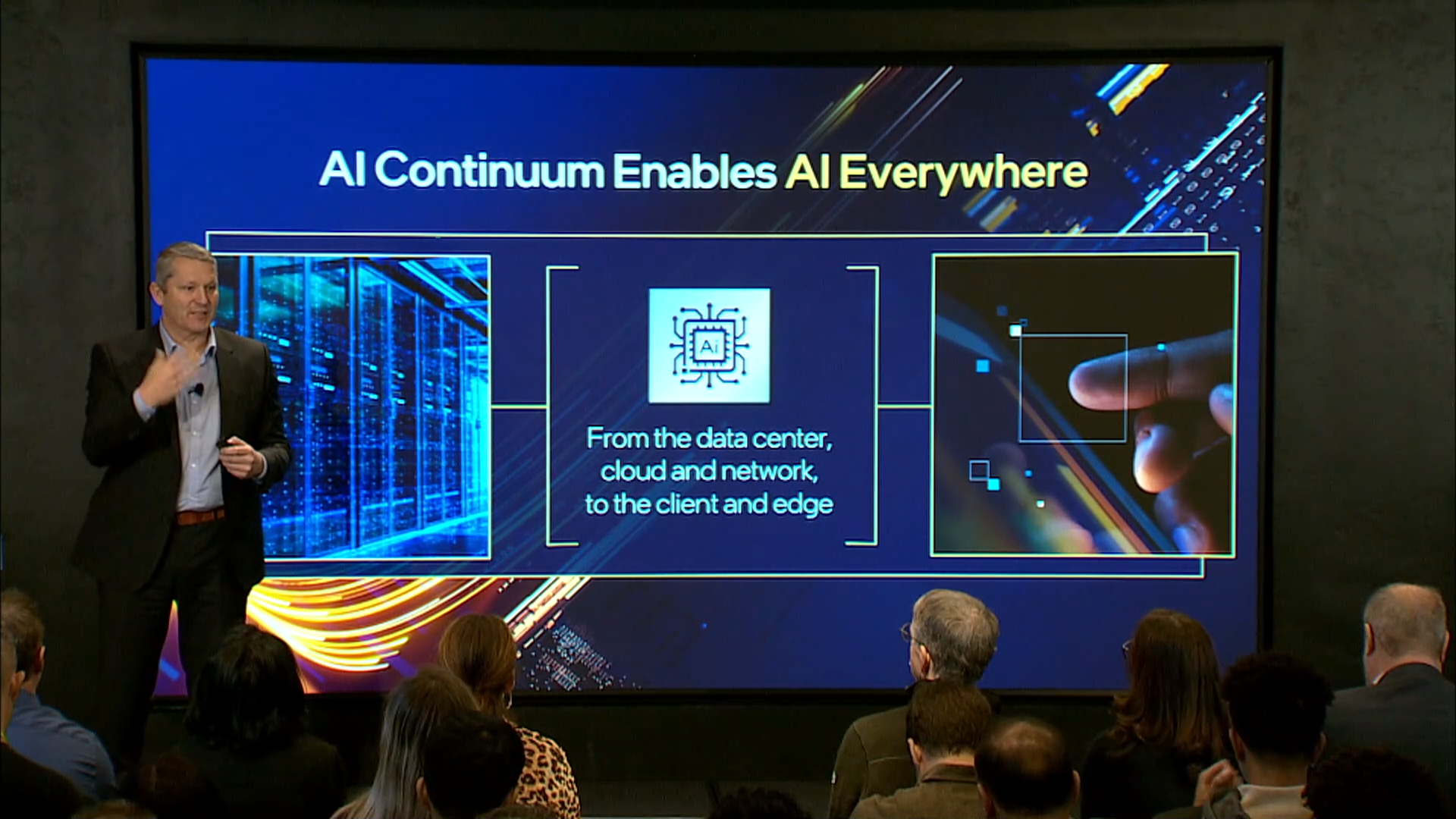
And here's Intel's Rivera coming back onstage to wrap up the event.
Oh wait, not quite yet— first she's inviting Intel CCO Christoph Schell on stage to talk up "how we're thinking about this from a go-to-market point of view."
"It takes a village to bring AI everywhere," says Schell, as he talks up how his team works to sell AI products and services to clients at the "edge" of where the Internet touches the real world — think the PC in your car, the sensors in your smart oven or the chips in the MRI machine at your local hospital.
"The edge represents $445 billion of global market opportunity," says Schell. "This is huge."

After another quick promo from a partner, this time Zoom, Intel's Schell is back on stage talking about how the company has worked with Samsung to integrate Intel Core Ultra chips into Samsung Medison ultrasound imaging devices.
"Why do Intel customers like us?" Schell is now asking, which (unless you're a business hoping to partner with Intel) is our cue to start wrapping up and mulling over what we've learned today.
Oh wait, the camera guy just cut to someone handing Intel CEO Pat Gelsinger something...now Pat's demanding to come up on stage....

Okay, seems like a planned move for Pat to "interrupt" the closing wrap-up to show off the new Intel Gaudi 3 supercomputer chip. Now Schell's handing things off to Gelsinger so Intel's CEO can wrap up with a simple "thank you so much for joining us today."

Well, I gotta say, we didn't learn a ton of new information about Meteor Lake chips or the "AI laptop" future Intel has been pitching us on, but it was a pretty fun and watchable livestream!
While our own Tony Polanco heads off to check out what Intel's demoing in NYC we're going to be wrapping things up here and updating this article with a recap of all the major news from today's event.
But there's no need to wait, because you can read all about what it's like to use one of these new Meteor Lake laptops in our hands-on reports linked below!
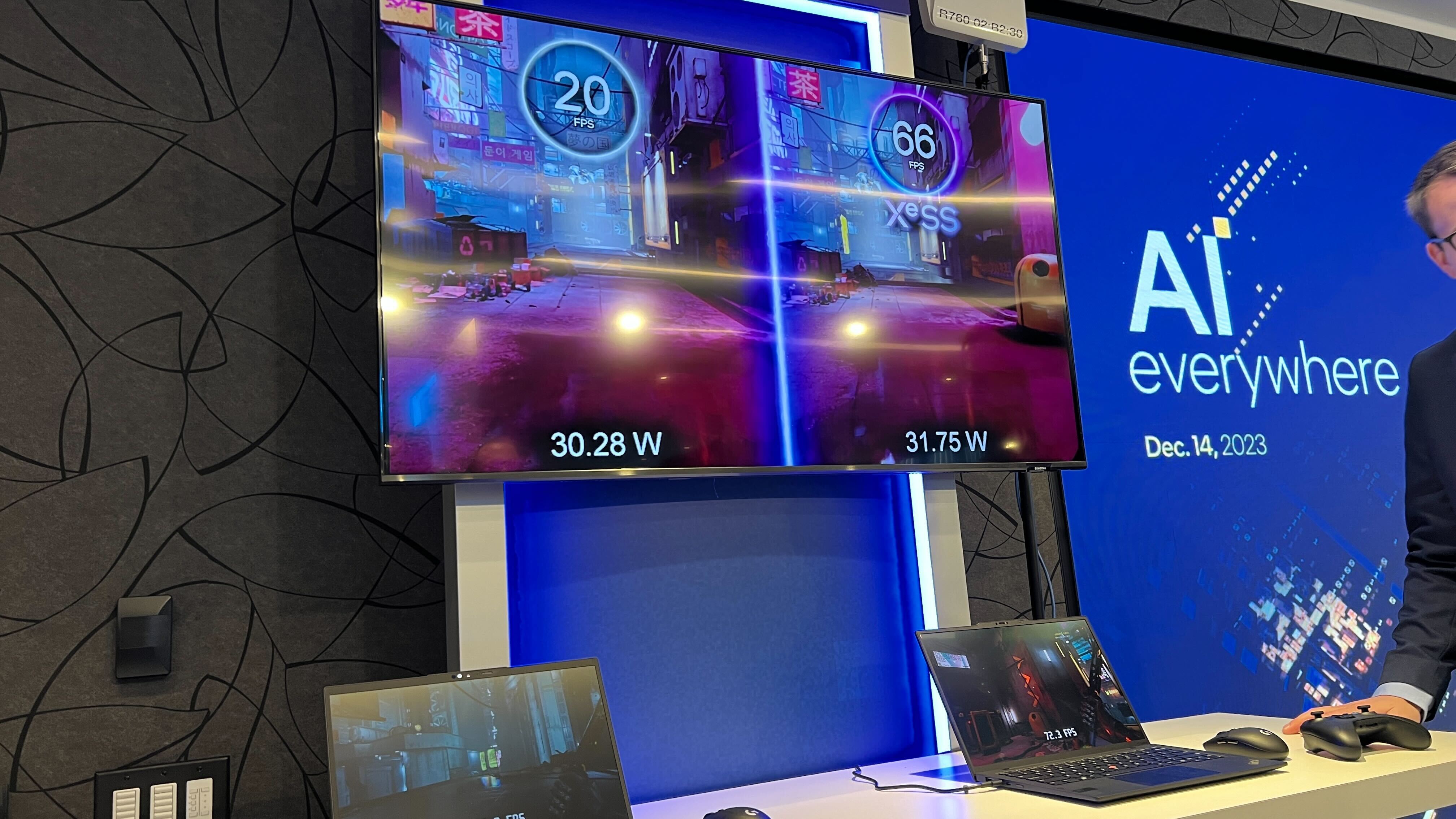
Here's a shot of a demo unit Intel has set up to show off the improved gaming capabilities of the high-end Meteor Lake laptop chips. Our own Tony Polanco is looking at these demos live right now, and as you can see it's Ghostrunner 2 running on two laptops side-by-side: One with a 13th Gen Core i7 CPU, the other with an Intel Core Ultra 7 chip.
The Intel Core Ultra laptop is the one on the right, and as you can see it's putting up higher FPS (frames per second) numbers. That big XeSS graphic is promoting Intel's XeSS supersampling tech, which works like Nvidia's DLSS to render scenes in a game at lower resolution than your display (so it can do the work faster and better), then use machine learning to "upscale" the scenes to the display resolution.
The net effect (ideally) is that you get a game running at high resolution as fast as if it were running at a much lower resolution, without a major loss of graphical quality. I can tell you I personally have seen this proven while playing games like Ghostrunner 2 and Like a Dragon Gaiden: The Man Who Erased His Name in an Acer Swift Go 14 packing a new Intel Core Ultra 7 chip, where I saw better-than-expected performance.
Now I didn't see the kind of performance increases over a similar laptop with an older 13th Gen Intel Core i7 that Intel is showing off live today, but that's to be expected since Intel is likely optimizing its demo units and environment to showcase the gaming power of Meteor Lake to full effect.

Intel's also showing off ways in which the "AI" muscle in these new Meteor Lake chips can be applied to not just generate new content but speed up existing workflows in productivity apps.
Here's a shot of Audacity running on a Meteor Lake laptop, which makes sense since Audacity is one of the first apps we've seen to lean hard into AI to do things like filter out curse words, remove background noise and more.

And here's a shot of two laptops demoing how the NPU in these new Meteor Lake chips can assist in apps like Zoom. If you look closely you can see that one video window is showing background blur generated by the GPU, while the other shows blur generated by the NPU.
The difference there is pretty small, but when you look at the resource monitors on the displays you'll see that the GPU is being noticeably taxed to blur the background in Zoom, while the NPU appears to be barely breaking a sweat.
This is the kind of advance Intel is promising: These new Meteor Lake chips will be able to do "AI" tasks locally much more efficiently than Intel chips in current laptops, and that means that in addition to saving money and privacy by ruining AI stuff locally you can also count on having more system resources available during video calls because the NPU can handle the camera effects, freeing up your GPU to do other stuff.

Now here's the demo I've been waiting all day to see.
This is a shot of a Meteor Lake laptop running Meta's Llama 2 LLM (large language model) locally, which you can tell by the fact that it says "Local" in the little drop-down menu in the top-right corner of the display.
With all the craze for "AI" chatbots and other LLM-powered services showing no signs of slowing in 2024, this is the demo I really wanted to see because it's one of the primary selling points of Meteor Lake. These chips are optimized to run LLMs and generate assets like text, images and video using less power than older chips, and having them run an assistant chatbot powered by an LLM right on your laptop is what's going to take services like Windows Copilot from being interesting to potentially life-changing.
In addition to the money you save on bandwidth and paying for credits (or whatever other method LLM distributors use to limit your access to tools like Bing Image Creator), running these kinds of applications locally gives you better privacy (since you're not sending information to a server) and potentially more useful, integrated and nuanced features that tailor themselves to your unique needs.
However, at the moment it's all still pretty nascent. As you can see from this image, the value of having an AI chatbot running locally on your PC is a little less if you're going to be asking it for things it needs to search the Internet for anyway, like recipes, directions and summaries.
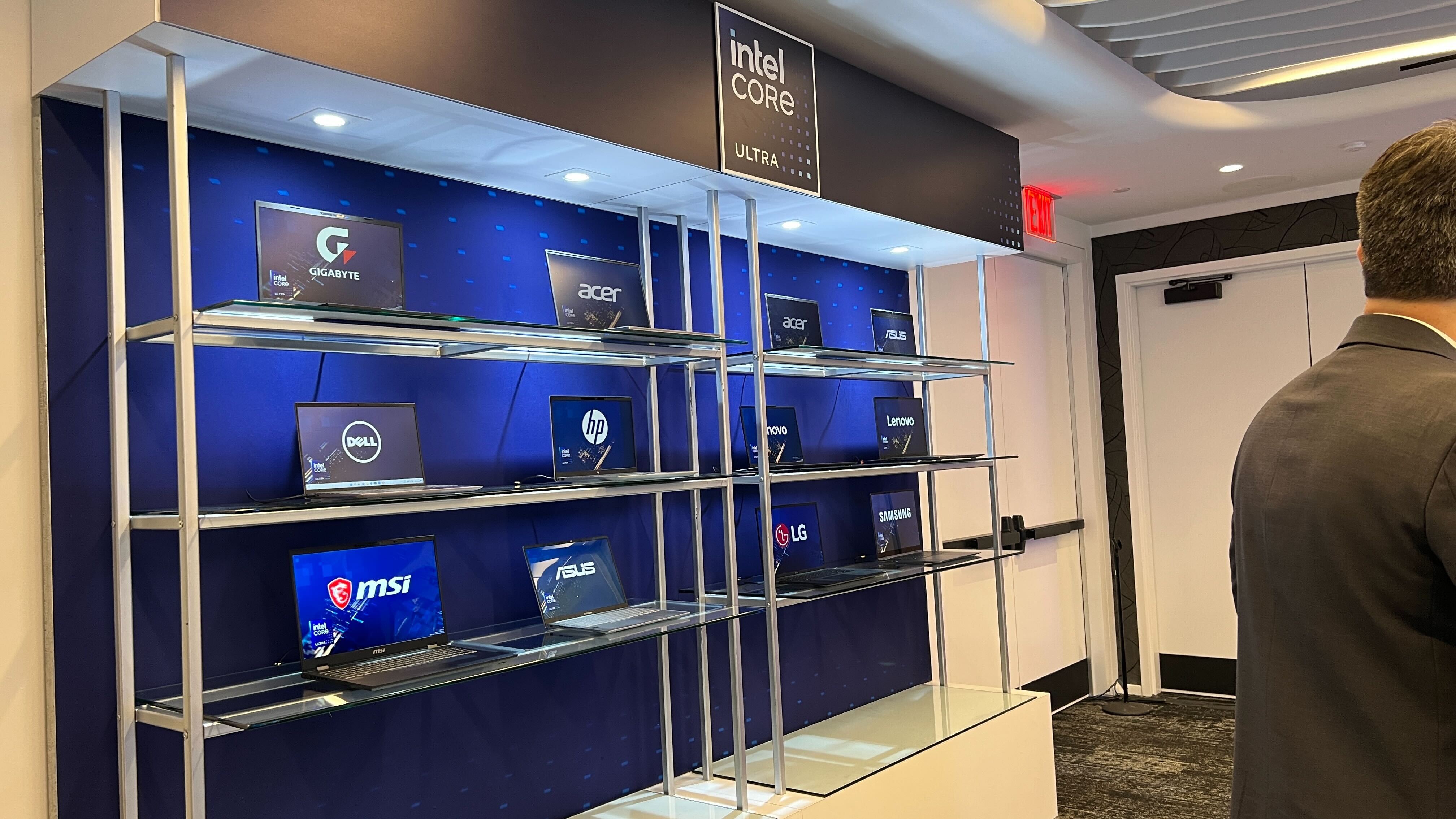
And here's a glimpse of the wall of laptops on display at the Intel "AI Everywhere" event, featuring notebooks from Acer, Dell, HP, MSI and more. These are among the first "AI laptops" launching today, and you can expect lots more to come in 2024.

So what laptops are going to be powered by Intel's new AI superchip? We've got a roundup of all the new Meteor Lake laptops available to buy now. This includes the new Acer Swift Go 14 (starting at $999), the MSI Prestige 16 AI EVO (from $1,699) and the Lenovo ThinkPad X1 Carbon Gen 12 (from $2,989).
